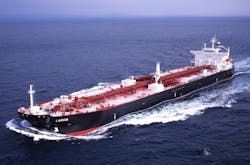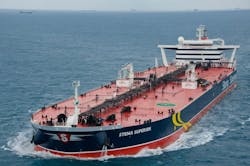Recent analysis by the Energy Information Administration (EIA) indicates that about 63% of the world's oil production – some 56.5 million barrels per day! – is transported via maritime routes, yet many of those routes traverse some increasingly dangerous waters, especially the Strait of Hormuz, leading out of the Persian Gulf, with Iran on one side glaring down upon its neighbors and much of the rest of the world, too.
[For more detail, visit the EIA’s World Oil Transit Chokepoints special analysis brief. It’s well worth reading.]
“World chokepoints for maritime transit of oil are a critical part of global energy security because of the high volume of petroleum and other liquids transported by these routes,” EIA noted in its analysis.
“Blocking a chokepoint, even temporarily, can lead to substantial increases in total energy costs and world energy prices, as disruptions to these routes can affect oil prices and add thousands of miles of transit in alternative routes,” the agency said. “Chokepoints also leave oil tankers vulnerable to theft from pirates, terrorist attacks, shipping accidents that can lead to disastrous oil spills, and political unrest in the form of wars or hostilities.”
EIA added that the aforementioned Strait of Hormuz and the Strait of Malacca, linking the Indian and Pacific Oceans, are the world's most important strategic chokepoints measured by volume of oil transit, accounting for a combined 57% of all seaborne oil trade.
In fact, back in 2013, about 17 million barrels per day traveled through the Strait of Hormuz alone – again, the waterway that connects the Persian Gulf with the Gulf of Oman and the Arabian Sea.
The Strait of Malacca, by contrast, is the shortest sea route between the African and Persian Gulf suppliers and the Asian consumers. At the end of 2013, oil shipped through the Malacca straits totaled 15.2 million barrels per day, according to EIA’s numbers.
Here are a few other key maritime transport routes for oil:
- The Suez Canal and SUMED Pipeline, located in Egypt, serve as strategic routes for Persian Gulf oil and natural gas shipments to Europe and North America.
- The Bab el-Mandeb strait – a chokepoint between the Horn of Africa and the Middle East – serves as a “strategic link” between the Mediterranean Sea and the Indian Ocean.
- The Danish and the Turkish Straits are key oil export routes to Europe for Russia and other Eurasian countries, including Azerbaijan and Kazakhstan.
That being said, the agency said that the Panama Canal is undergoing an expansion, scheduled to be completed next year – and expansion that should allow transit for larger ships with greater volumes, including liquefied natural gas tankers.
The increase in domestically-produced crude oil here in the U.S. is also altering global oil trade patterns, too.
“Historically, U.S. refiners were major consumers of African crude oil, primarily light sweet crude from Nigeria, Algeria, and Angola,” EIA pointed out in its report. “However, with increased U.S. production of light, sweet crude, the U.S. has imported less crude oil from Africa, and more African crude has been sent to Asia through the Strait of Malacca.”
Thus, despite reducing our nation’s oil imports via such “chokepoints,” our new energy export stream must transit those very same spots in reverse – something to keep in mind even as diesel and gasoline prices continue falling here at home.





